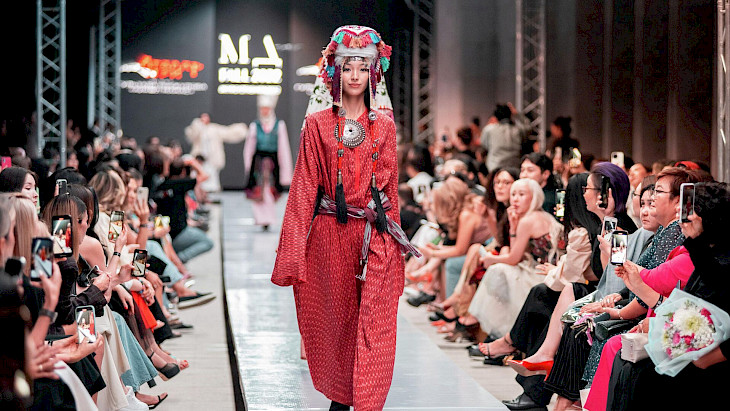Flora Baibolova, Bishkek
In the world of fashion, it is often said that creating something truly original is no longer possible, and that fashion is cyclical, with everything that seems new to us having already existed and undergone metamorphosis. But not here. Where fashion is dictated through the megaphone of Western globalization, it may be that everything has long been borrowed from other decades, but not in our region. Central Asia, like an oasis of novelty, is a source of culture so rich, ancient, and largely unexplored. It is thousands of years of traditions that people have preserved with reverence, what our ancestors passed down to us with pride and honor. Often, when entering luxury boutiques in the capitals of Europe, it is not uncommon to see familiar ornaments adapted to the aesthetic demands of the modern Western market.
Many Italian and French brands often draw inspiration from our culture. Some give it the recognition it deserves. For example, Hermes; in its Spring/Summer 2017 collection, the French fashion house presented "Appaloosa des Steppes" - a collection of silk scarves and handkerchiefs designed by artist Alice Shirley, inspired by the geometric motifs and vibrant colors of tribal carpets, which are better known to us as "shyrdaks." I remember how proudly I showcased those coveted 10 letters, which make up the name of my country, on the website of the most famous fashion house. How proud I was when Stella Jean, an Italian designer whose works are dedicated to our culture, appeared on the Vogue website. But I also remember being shocked and offended when I saw the same ornaments adorning designs from other brands, shamelessly carrying their own labels without a mention of their origin. And then I began to wonder how difficult it would be for our designers to survive and compete with giants who use and draw inspiration from our culture in the vast fashion market, passing it off as their own. But I was much younger then, before I received my education in fashion and before I worked in this industry. With knowledge and experience came the realization that no one can tell our story better than we can ourselves.
Looking at designs that imitate but do not feel the culture, there is always a sense that something is missing. Over the past couple of years, I have observed how many young, talented designers from Central Asia hit the mark and convey the exact emotions that people experience living in this reality. The angular, confident movements of skilled riders, the gentle touch of rural women weaving significant ornaments into shyrdaks, the sounds of the strings of the Dombra or Komuz echoing in the minds of all who have heard them once...
As it turns out, culture can be understood, or it can be felt. It is possible to borrow and create something beautiful, and in the West, this has become the norm, as there is very little left for them to explore. But only a person who feels something in their blood can recall reality on a biological level and, through centuries and generations, create something entirely new through the prism of their personal perception.
That is why the main task of our modern designers, in addition to creating beautiful things, is to skillfully narrate the story, explore deep historical values, and ethnic roots. This is an ode of gratitude to all the young talents and art scholars who dig deeper and return to the origins of our beautiful, rich culture. This is an ode to all the institutions that support them in the process. Trust in your vision, your instincts, and know that our culture is in our blood, and no one can take that away from us.
Photo: Twitter, IA 24.kg

